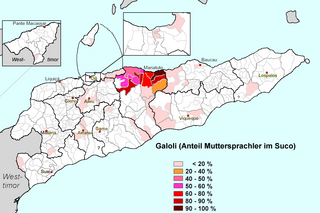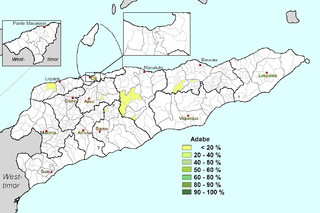Related Research Articles
Hawaiian is a Polynesian language and critically endangered language of the Austronesian language family that takes its name from Hawaiʻi, the largest island in the tropical North Pacific archipelago where it developed. Hawaiian, along with English, is an official language of the US state of Hawaii. King Kamehameha III established the first Hawaiian-language constitution in 1839 and 1840.

Italian is a Romance language of the Indo-European language family that evolved from the Vulgar Latin of the Roman Empire. Italian is the least divergent Romance language from Latin, together with Sardinian. Spoken by about 85 million people including 67 million native speakers (2024), Italian is an official language in Italy, San Marino, and Switzerland, and is the primary language of Vatican City. It has official minority status in Croatia and in some areas of Slovenian Istria.

The International Phonetic Alphabet (IPA) is an alphabetic system of phonetic notation based primarily on the Latin script. It was devised by the International Phonetic Association in the late 19th century as a standardized representation of speech sounds in written form. The IPA is used by lexicographers, foreign language students and teachers, linguists, speech–language pathologists, singers, actors, constructed language creators, and translators.

The Romance languages, also known as the Latin or Neo-Latin languages, are the languages that are directly descended from Vulgar Latin. They are the only extant subgroup of the Italic branch of the Indo-European language family.
Slovak is a West Slavic language of the Czech–Slovak group, written in Latin script. It is part of the Indo-European language family, and is one of the Slavic languages, which are part of the larger Balto-Slavic branch. Spoken by approximately 5 million people as a native language, primarily ethnic Slovaks, it serves as the official language of Slovakia and one of the 24 official languages of the European Union.
Structured Query Language (SQL) is a domain-specific language used to manage data, especially in a relational database management system (RDBMS). It is particularly useful in handling structured data, i.e., data incorporating relations among entities and variables.

Malayalam is a Dravidian language spoken in the Indian state of Kerala and the union territories of Lakshadweep and Puducherry by the Malayali people. It is one of 22 scheduled languages of India. Malayalam was designated a "Classical Language of India" in 2013. Malayalam has official language status in Kerala, Lakshadweep and Puducherry (Mahé), and is also the primary spoken language of Lakshadweep and is spoken by 35 million people in India. Malayalam is also spoken by linguistic minorities in the neighbouring states; with a significant number of speakers in the Kodagu and Dakshina Kannada districts of Karnataka, and Kanyakumari, Coimbatore and Nilgiris district of Tamil Nadu. It is also spoken by the Malayali Diaspora worldwide, especially in the Persian Gulf countries, due to the large populations of Malayali expatriates there. They are a significant population in each city in India including Mumbai, Bengaluru, Delhi, Kolkata, Pune etc. Malayalam is closely related to the Tamil language.

The Galoli, or Galolen, are a people of East Timor with a population of about 50,000, primarily along the northern coast of the district of Manatuto. To the west lies the Mambai people. There is an old colony on the southern coast of Wetar island, the Talo, who speak the Talur dialect.

Wetarese is an Austronesian language of Wetar, an island in the south Maluku, Indonesia, and of the nearby islands Liran and Atauro, the latter island separate from the mainland of East Timor, north of Dili.

English is a West Germanic language in the Indo-European language family, whose speakers, called Anglophones, originated in early medieval England. The namesake of the language is the Angles, one of the ancient Germanic peoples that migrated to the island of Great Britain.
The Orang Laut language or Loncong, is one of the Malayic languages. It is one of several native languages of Orang Laut of the Bangka and Belitung islands in Indonesia, and may be two distinct languages.
The Finisterre languages are a language family, spoken in the Finisterre Range of Papua New Guinea, classified within the original Trans–New Guinea (TNG) proposal, and William A. Foley considers their TNG identity to be established. They share with the Huon languages a small closed class of verbs taking pronominal object prefixes some of which are cognate across both families, strong morphological evidence that they are related.
Rai Coast District is a district in the southeast of Madang Province in Papua New Guinea. It is one of the six districts that of the Madang Province. The District has four local level government (LLG) areas namely; Astrolabe Bay, Nahu Rawa, (Nankina, Yupna & Domung and Saidor. The District has 84 ward areas. The largest local government area is Saidor which has 42 wards.
Nankinian is one of the Finisterre languages of Papua New Guinea. Nankina Wam, Domung Meh, and Yupno Gen. are related varieties.
Bulgebi is a nearly extinct Finisterre languages of Papua New Guinea. It is spoken in the Madang province near the Astrolabe Bay and the lower Nankina river, slightly inland on the eastern end of the southern coast.
Zazao is an Oceanic language spoken in the Solomon Islands. Its speakers live on Santa Isabel Island. It is classified as “critically endangered” by the UNESCO Atlas of the World’s Languages in Danger, because its speakers usually speak the Cheke Holo language or the Zabana language.
Dampelas (Dampal) is a Celebic language of Sulawesi in Indonesia. It is the main language of Dampelas District (kecamatan).
Lauje is a Celebic language of Sulawesi in Indonesia. Ampibabo, spoken in Ampibabo District, may be a separate language.

A transformer is a deep learning architecture developed by Google and based on the multi-head attention mechanism, proposed in a 2017 paper "Attention Is All You Need". It has no recurrent units, and thus requires less training time than previous recurrent neural architectures, such as long short-term memory (LSTM), and its later variation has been prevalently adopted for training large language models (LLM) on large (language) datasets, such as the Wikipedia corpus and Common Crawl. Text is converted to numerical representations called tokens, and each token is converted into a vector via looking up from a word embedding table. At each layer, each token is then contextualized within the scope of the context window with other (unmasked) tokens via a parallel multi-head attention mechanism allowing the signal for key tokens to be amplified and less important tokens to be diminished. The transformer paper, published in 2017, is based on the softmax-based attention mechanism proposed by Bahdanau et. al. in 2014 for machine translation, and the Fast Weight Controller, similar to a transformer, proposed in 1992.
NNK may refer to:
References
- ↑ Nankina at Ethnologue (25th ed., 2022)

- ↑ Organised Phonology Data, Nankina Language [NNK], Teptep – Madang Province, 2011